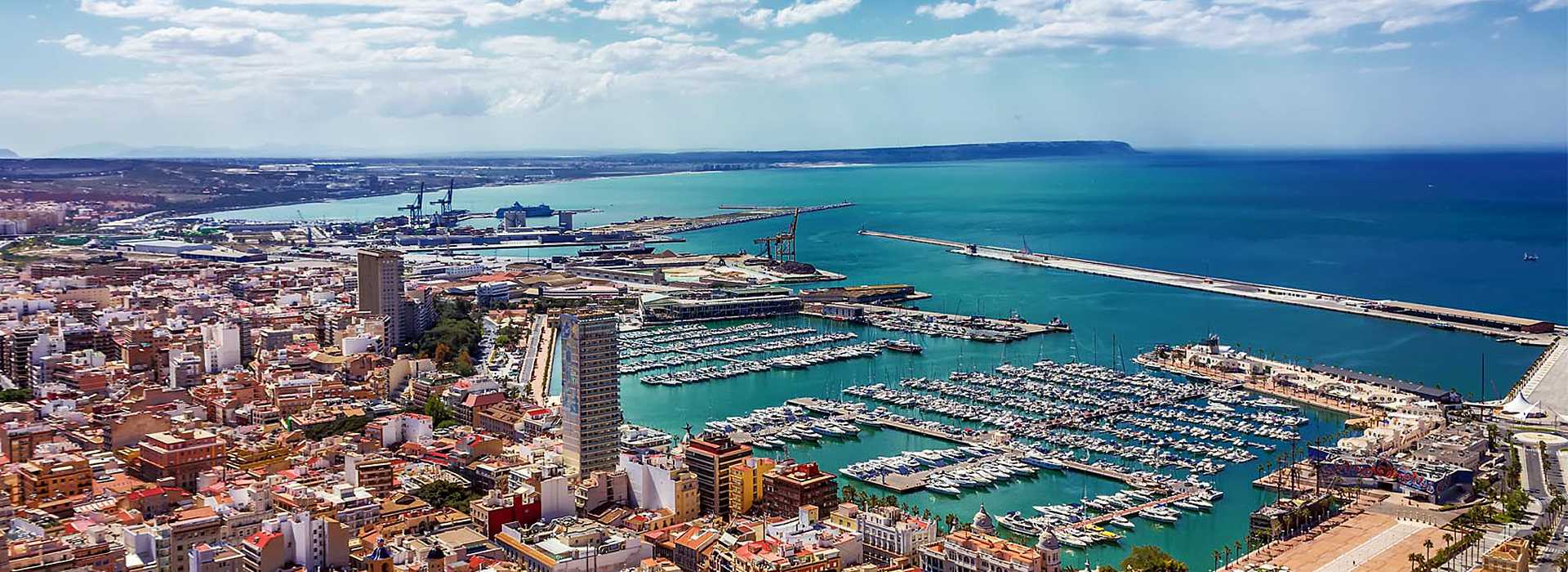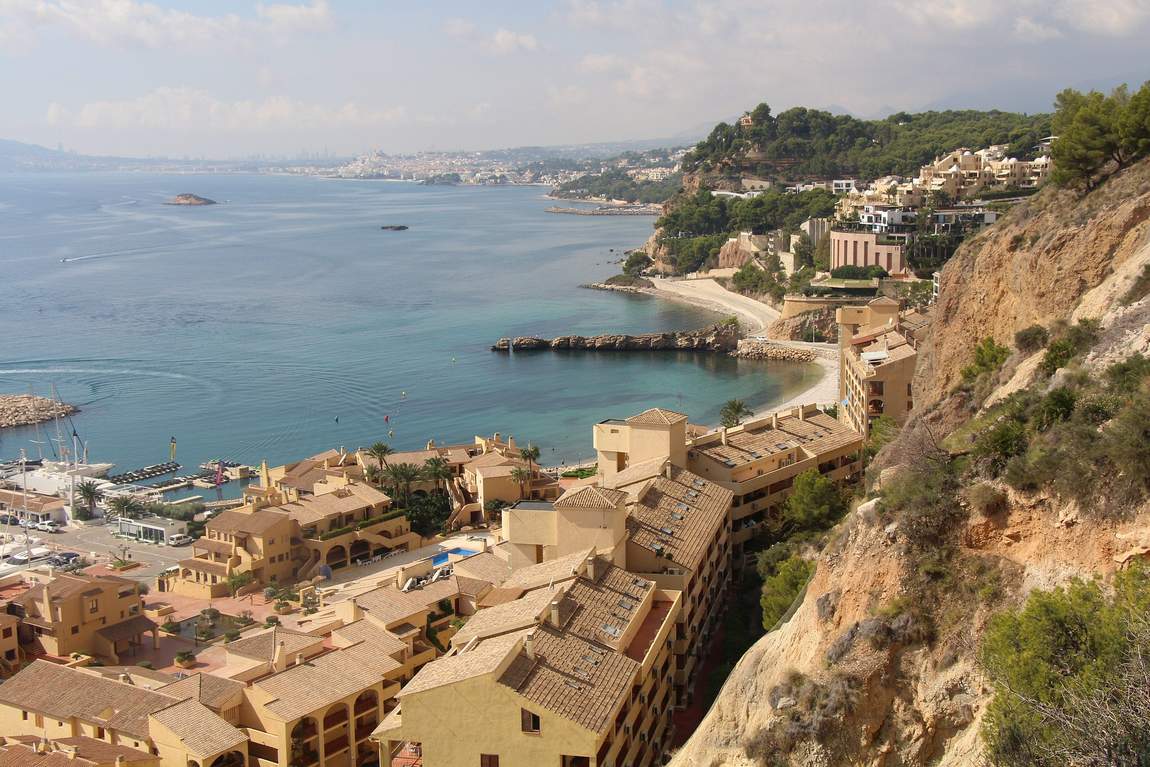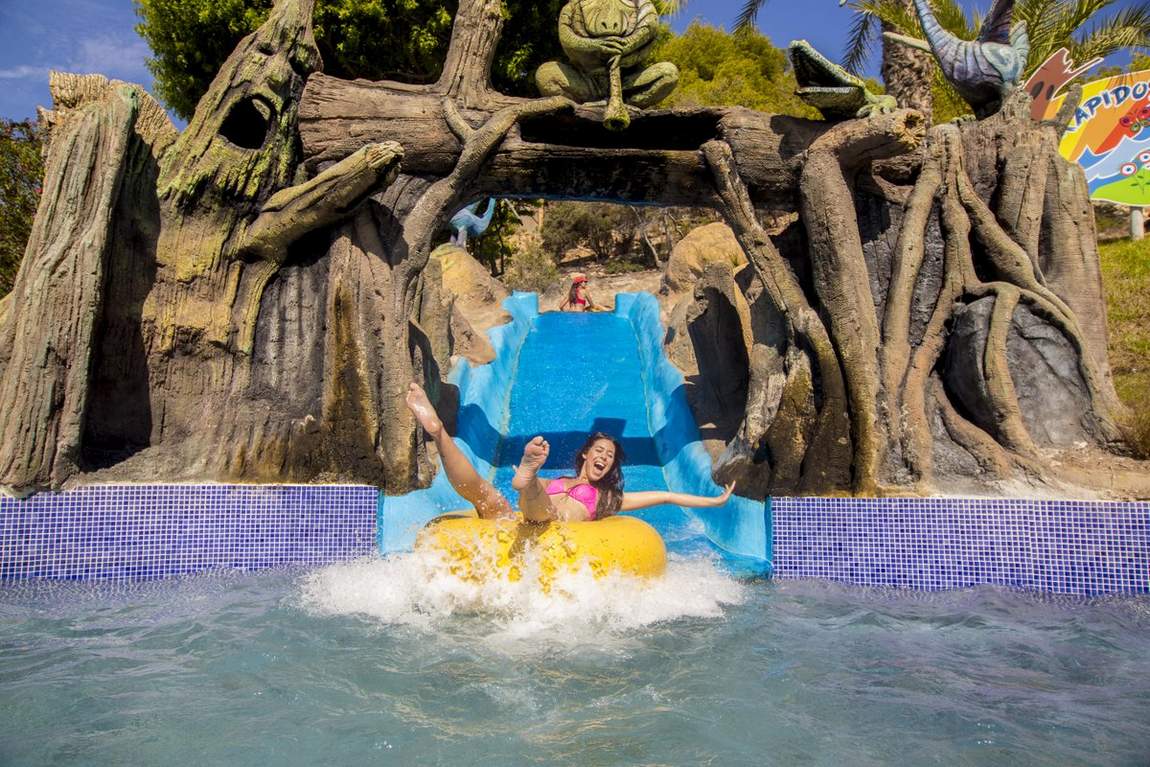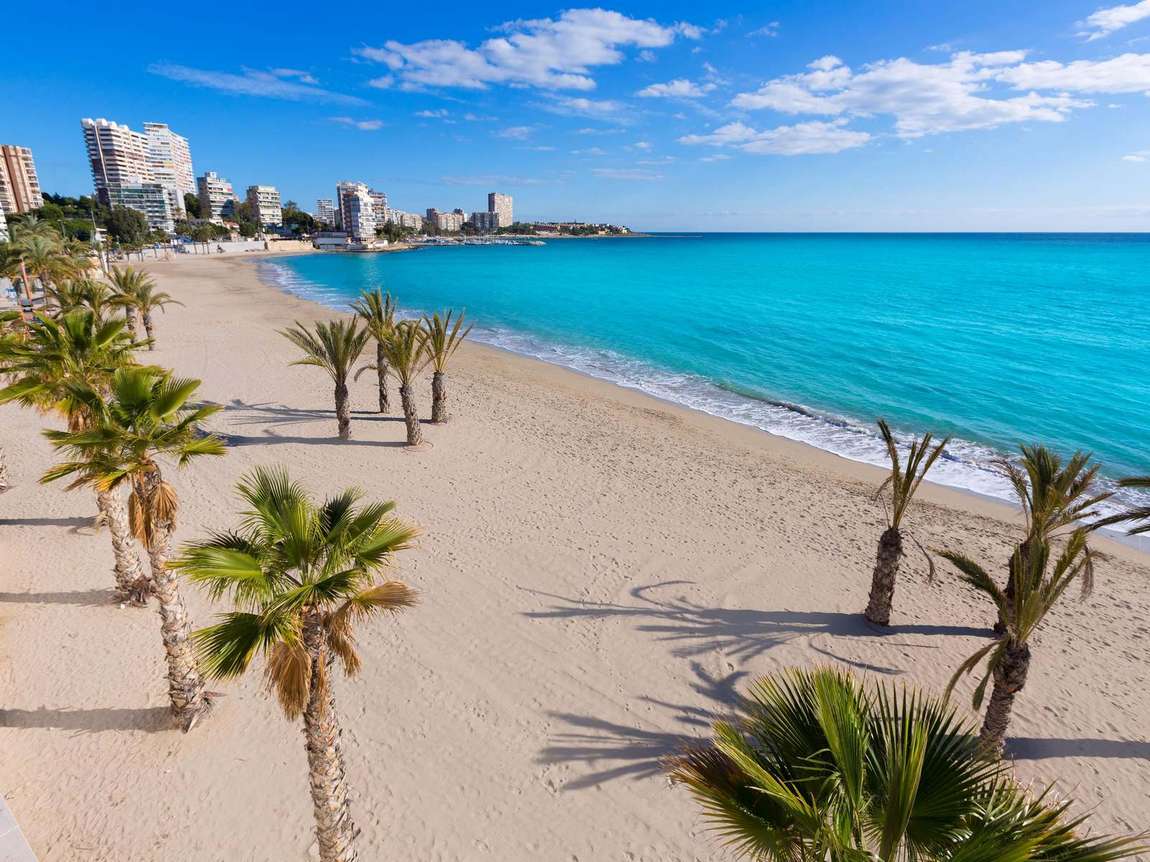Family holidays in Alicante
Distinguishing Alicante from other resorts in Spain is difficult (all are good), but it is possible. With the general pros — warm summers, beautiful beaches, comfortable hotels — Alicante has one undeniably convenient feature: its airport. Therefore family rest begins approximately half an hour after arrival when you leave things in the hotel and leave on a beach where the sun has already heated the sand and the sea caresses to feet.
But apart from that, a holiday with kids in Alicante is like a beach holiday. Find out how to choose when to go to the sea and what Alicante offers.
Alicante on the map of Spain
The city of Alicante is a resort in eastern Spain on the Mediterranean coast. It is the province's administrative centre of the same name in the autonomous community of Valencia. The distance from Alicante to Valencia is 170 km, to Benidorm 46 km and Torrevieja 50 km.
Alicante's coastline is called the Costa Blanca, the white coast. Many beaches are covered with fine white sand, which complements the blue of the sea, sky and blue flags. The sand on Alicante's beaches is predominantly golden in colour (also beautiful). By the way, Alicante has its assessment of the quality of its beaches, as well as hotels, restaurants and tourist companies. The SICTED mark confirms that you will receive the highest quality services.
Alicante for Kids

There are many reasons to come to Alicante with children. We've already listed the main attractions of the resort, but it's a pleasure to repeat them:
- the resort is easy to get to;
- Alicante summers are dry and sunny;
- the beaches are ideal for babies and toddlers;
- the hotels make sure that you and your baby have a good time.
The city transport should also be mentioned. City buses provide easy access to beaches or supermarkets, and the tram can even take you to Benidorm.
To add to this list of the advantages, Alicante has plenty of playgrounds for children and several parks where they can hang out in the heat.
Alicante's parks are significant pros for those going on holiday with an infant. Unlike the southern resorts of the province, where the landscape resembles a sun-burned steppe, Alicante's abundance of greenery ensures that the heat of summer is not felt.
But you should know a few things about the resort to avoid disappointment. Firstly, it's a relatively big city where many tourists settle. You'll need to leave Alicante for a soft tan on the beach during the peak season. Another drawback to family holidays in Alicante is the lack of entertainment in the city itself. A trip to Benidorm or Torrevieja will spice things up. A trip to Valencia can also be made to the City of Arts and Sciences, with great museums for the whole family.
Best Time to Travel
The tourist season in Alicante is a pleasant but busy time. The joys include the heat, the sea, the excursions and the holidays. The downsides include many visitors, especially in July and August, skyrocketing prices and the need to book accommodation well in advance.
When is the best time to go to Alicante to avoid the crowds? The flow of tourists starts to subside in September, and by the middle of the month, the beaches and hotels will be half-empty. The weather at this time is suitable for both sightseeing and beach holidays.
You can bring your children even before the season opens in Alicante, in May or early June. The only drawback is the cool sea, but the weather is fine for relaxing on the beach and walking.
Plans can also be attached to exciting events in the resort. The Moors and Christians Festival and the St. Juan's Bonfires Festival are celebrated in summer, the Carnival in winter, and the religious festivals are revered throughout the year. A calendar of cultural events is published on the resort's website. ManyIn Alicante, the bullfighting season begins in June, coinciding with the celebration of St. Juan's Day. Many travellers long to see a Spanish bullfight.
Weather and Climate

For tourists, Alicante's climate is a gift. Six-month summers, clear skies, warm seas — isn't that what middle-latitude residents tired of winter are dreaming of? The first holidaymakers rush to the resort as early as May. By this time, the air's temperature reaches +23-24°С. The sea is still cold, but the weather is perfect for baby holidays in Alicante.
From June, the air temperature (and sea temperature) begins to rise steadily. If in early summer, the thermometers show +25-27 ° C, by July, the thermometers are getting up to +30-31 ° C.
August is the hottest month, with temperatures rising as high as +31-32°C. The only saving grace is that the humidity in Alicante is low, so the heat is not felt.
The arrival of calendar autumn in Alicante is unnoticeable. Temperatures are still around the +28-30°C mark, the sun shines relentlessly, and the sea is luxuriously warm. The best time to visit Alicante with children is in September when the heat sinks and the sea cools down. However, you can also plan your holiday in Alicante for October. The first half of the month is still very warm, with temperatures not dropping below +25° C. The occasional rain showers are a blessing after the dry summer.
By November, summer finally wears off. Temperatures drop to +17°C, and in December and February to +15-16°C. It's chilly for a beach holiday, but the clear weather makes for pleasant walks. March is the rainiest month. The city is particularly colourful after the rains, and with temperatures rising to around +18-20°C in mid-spring, it's time to plan an early visit to Alicante.
Bring a warm blouse, a light jacket, and a thin hat if you're going on holiday with a baby. The extra clothing comes in handy in the evenings when the temperatures drop. Evenings in June and September are warm, around +20-23°C, but the temperature drops to +16-17°C at night in May and October.
Sea Temperature

"May in Alicante is still spring, not summer," say pessimistic tourists. This pessimism is based on the fact that the sea temperature in late spring hardly reaches +19-20°C. It does feel a bit cold for bathing: if you plan a trip to a resort in May, choosing a hotel with a swimming pool makes sense. In summer, with the arrival of the heat, the sea warms up quickly. By mid-June, the water temperature in Alicante rises to +23°C.
Alicante has its warmest sea in July and September. During this period, the water gets as warm as +25-27°C.
You can take long sea baths until mid-September. Then the water temperature gradually drops to +23°C. Even in October, many people dare to dip in the sea. It's not until November that the water cools down to 20-21°C.
Food
The all-inclusive concept is unpopular in Alicante hotels. More often than not, tourists only have breakfast at the hotel, preferring lunch and dinner in restaurants or tapas bars. Sometimes hotels offer a packed lunch. You can take it with you if you'll be travelling all day.
Alicante's restaurants offer a variety of delicious dishes, including the famous paella dish from Valencia. The 'horchata de chufa', a refreshing drink made from ground almonds, is available during the summer in Alicante and other towns in the Valencian Community.
If you plan to make your food, the nearest supermarket is an excellent place. Large Supercor, Carrefour, Mercadona, Lidl, Consum, and DIA shops exist in all city areas, including Albufereta and San Juan. For fresh vegetables, fruit, fish, jamón, sausages and cheeses you can go to the central market or smaller markets away from the centre. The markets usually close in the afternoon and are closed on Sundays.
Getting Around

Public transport in Alicante is in high demand: the city is not small, and not every beach or attraction is easily accessible on foot. There are fifty bus routes and five tram lines for residents and visitors. There are maps of all the routes on the city's tourist website.
Public transport in Alicante runs from 6:00-6:30 until 23:00, with two night bus routes. The exact timetable is available on the carriers' websites.
There are red and blue buses in the city. The blue buses are intercity, but you can ride them around Alicante. You can buy tickets from the driver or ticket vending machines. A city bus fare is €1.45. To save on tickets for children aged 5-15, you can buy a Bono Móbilis Escolar card for 30 rides. The cost is €16.50. An adult's Bono Móbilis Multiviaje card with 30 rides costs €26.10.
The cost of a tram ticket varies depending on the zone in which it is valid. Zone A covers Alicante, and three tram lines run within this zone. Zones B and C are the nearest suburbs of Alicante, all the way to Benidorm: you can get there on the L1 tram. Zones D-F are the resort towns between Benidorm and Denia (line L9). A single-trip ticket is valid for Zone A and costs €1.45.
You can buy Bono tickets for 10 (30) trips to save on fares. They cost €8.70 (26.10) within Alicante and €7.60 (21.50) outside the city. A tram trip to Benidorm will cost €3.75.
Another way to save money on travel is to buy the AlikanteToutistCard. With it, you can travel unlimitedly on buses, coaches, trams and the Alicante Tourist Bus.
Sometimes taxis are handy for getting around Alicante. Taxis are equipped with meters, and the fare within the city is between €5 and €10. Free cars are waiting for passengers in the car parks.
Is it worth hiring a car in Alicante? If you're not travelling around the city, it's unlikely to be justified. The old town centre is a jumble of narrow one-way streets with a lack of parking spaces. In the newer neighbourhoods, traffic is more accessible, and there is paid and free parking.
But to visit Benidorm, Torrevieja and Valencia, you can rent a car: car rental companies have offices at the airport and train station.
Things to Do with Kids

Family holidays in Alicante do well without planning. There are beaches, a castle on a rock, a beautiful old town, a zoo and children's playgrounds. So where to start?
City Walks
You can get a first impression of Alicante by taking the Turibús bus. The bus makes ten stops along the way: it stops at the port, goes up to the archaeological museum and Santa Barbara Castle, and stops in the Santa Cruz area with its staircase streets and almost toy houses. Get off at any stop and then continue to the next bus.
For example, the Santa Barbara Fortress will be fun for a child. You can explore all the rooms of the history museum, walk along the castle walls, gaze out at the city below and peer out at sea through the eyepiece of a modern telescope. On the slopes of Benacantil Hill, where the castle stands, there is a park where you can take your child for a walk and then go down to Postiguet Beach... in a lift.
There are plenty of parks in Alicante, including the oldest park in the city, Canalejas, the relatively new El Palmeral park with its towering palm trees and Lo Morant Park with its skateboarding and petanque fields. Of course, all the green areas have playgrounds for children.
The Aitana Safari Park, on the other hand, is not very green. The landscape looks more like an African savannah, and elephants, giraffes and antelopes are walking there. However, there are animals from different parts of the world in "Aytan".
When the heat dies down in the evening, take the kids to Mundo de los niños, a small amusement park. The usual rides are no longer the usual attractions in this park: a trampoline has been transformed into a pirate ship, and a children's steam train takes the children to visit hippos and giraffes.
The Virtual Planet indoor play centre, has trampolines, table and video games, mini-bowling and other fun activities. There are similar centres in many shopping malls.
Entertainment in the Neighbourhood

Although Alicante is the province's centre, there's not much to do. You'll have to go to the neighbouring towns to have fun with the kids. Benidorm is where most of the fun is to be found. The list is impressive:
Torrevieja can't boast so many attractions, but there are two water parks in the city: the bigger one, Aquopolis, and the smaller one, Flamingo. Torrevieja is also home to a real submarine, the S 61 Dolphin, and the sailing ship Pascual Flores, which used to deliver Torrevieja salt to other countries.
The Beauty of Nature
When looking for ideas for things to do in Alicante with your child, we recommend getting out of the city and into the great outdoors. The area around the central city of the province is rich in places of interest, such as the Algara Waterfalls Park, the Canelobre Cave, the palm forest near Elche and the island of Tabarca.
Nature experiences include a walk through Elche's Rio Safari Park.
You can have a picnic if you prefer a quiet holiday in nature rather than a race to the sights. There are picnic areas in zoos, nature parks and just about every green space you can think of.
The Sea and Beaches

Even the driest description of Alicante's beaches evokes dreams of relaxing by the sea:
- a dozen and a half sandy beaches have been awarded the blue flag for coastal cleanliness and safety (of which four are within the city limits, the rest are 5-15 km from Alicante);
- six beaches awarded by SICTED for high-quality service;
- wide shore covered with fine sand;
- smooth, gentle seabed;
- free access to all beaches (but there is a charge for renting sun loungers and parasols).
The town's central and most popular beach is Postiguet. It's both award-winning and popular with tourists. The definite pros of Postiguet Beach are the scenic view (Santa Barbara Castle looms directly over the beach), its vast length, good infrastructure, children's and sports grounds, many hotels nearby, and the possibility of parking next to the beach.
Besides those who want to laze by the sea, divers come to Postiguet. There are several diving centres on the beach where you can take a training course or rent equipment. There is one drawback: congestion during the high season.
Another award-winning beach is Albufereta. It is located in a relatively large bay on the north-eastern outskirts of Alicante. The sea is always calm, with children's slides and swings on the shore and fewer people than in the centre. It is one of the best beaches for children.
Next door to Albufereta is the equally famous San Juan beach. San Juan is visited by windsurfing enthusiasts. It is very long (2,900m), wide (85m), landscaped and consequently very busy.

Saladar Urbanova is the perfect beach for a relaxing holiday. The wide, long coastline is half-empty even during the high season because the beach is just outside the city, 5 km south of Alicante.
Alicante's most exotic beach destination is Tabarca Island. The coastline is narrow, and only the official beach has been cleared of rocks, but the sea near Tabarca is interesting for snorkelling, and the island is famous for its old fortress and tiny, intimate town.
You can also relax on the beaches of the neighbouring resorts of Santa Pola and El Campello. You can get there by intercity bus or by car.
Attractions
The list of things to see with children in Alicante is short but surprising. There are typical historical and archaeological museums but also unexpected ones, like the Bonfire Museum or the Turrón Museum.
The Archaeological Museum of Alicante does not look like a warehouse of dusty shards. Even pre-schoolers can be taken on a guided tour, with bright or darkened rooms, plenty of multimedia and a virtual journey back in time.

To reinforce your impression, visit the ruins of the Roman city of Lucentum on the outskirts of Alicante. The excavations cover an area of 5 hectares and don't seem out of place against modern blocks of flats.
The Bonfire Museum, on the other hand, is a sight to behold. It's dedicated to the tradition of St. Juan's Bonfires. Here you can show your child the giant figures set up in the city streets during the festival. Some sculptures are very touching, and others have a sense of wicked irony.
The Turrón museum has a natural appearance in the city: this sweet treat originated in the province of Alicante. It used to be made only at Christmas, but now the turron can also be bought in the summer.
Is it any wonder that Alicante has a bullfighting museum? Bullfighting still takes place in Valencia's autonomous community, and the bullring in Alicante is one of the best. The museum tells more about bullfighting traditions, the famous bullfighters and why the bullfighting between bull and matador has been compared to ballet.
Another museum you can visit in Alicante with a preschool child. It is a small nativity scene museum, and the scene of the birth of the infant Christ is repeated many times in both ancient and modern versions.
Incidentally, the list of things to see in Alicante hardly mentions the exciting museum dedicated to the Volvo Ocean Race, a round-the-world yacht race. The multimedia facilities in the museum are excellent, providing a focus for visitors to immerse themselves in the constant struggle with the elements.
English and Spanish are used throughout. Admission to the museum is free, but visitors often leave money in the gift shop: valuable items with the regatta's logo will be useful as gifts.
Museums in neighbouring towns
If you drive around Costa Blanca, you will find even more exciting places for children.
You will find several museums at once in Guadaleste. The Museum of Vintage Motorcycles and Cars will appeal to men of all ages. The dollhouse museum will not only appeal to girls; boys will appreciate the mini-city with its train station. The Microgiant Museum is a tiny wonderland, not just a display of miniatures but a fantasy about little people's lives.
In Torrevieja, which has long been the centre of the salt trade, there is the Sea and Salt Museum. Admission is free, and exhibits include model ships, fishing gear and archaeological finds from the bottom of the sea.
The city of Elche is often visited by travellers on holiday in Alicante with children. In addition to the Rio Safari Park is the Paleontological Museum, with dinosaur skeletons and fossils that are hundreds of millions of years old. The museum has created an excavation area for the active kids: budding palaeontologists will be delighted with every find.
Where to Stay
Where to stay in Alicante with children? There is probably a place for those who love luxury holidays and tourists with modest needs. There are four-star hotels on the coast, near the Santa Barbara Castle, less posh triplets not in the centre but close to the sea, and apartments of varying levels of comfort — there is plenty to choose from.
Most hotels are concentrated in Alicante's central areas of Barri Vell Santa Creu and Raval Roig.
There is a high density of hotels and apartments in L'Albuffereta Playa and de San Juan, known for their beaches. This is where Santa Barbara Castle and Postiguet Beach are located. It is advisable to choose accommodation closer to the coast, as the town is on the hills and walking up the steep streets with a child after the sea isn't easy. Do note that the hotels in Alicante, as elsewhere in Spain, are not directly on the coast but are set back from it by a promenade and motorway. Generally, accommodation is close to the beach, with parking along the beach.
Parents often opt for family-run hotels when choosing where to stay with their children. The Costa Blanca is renowned for its family-friendly hotels, with Benidorm being particularly successful, but Alicante is not far behind.
The best hotels for holidays with children have family rooms, playgrounds, swimming pools for babies, and mini-clubs. Children's activities at the hotel are a way to keep your child occupied during those hours when the heat makes it impossible to go to the beach or out on an excursion.
When researching your options for where to stay in Alicante, look out for hotels marked SICTED. Several family-run hotels, including Castilla and Almirante, are near San Juan Beach.
On the other hand, there is plenty to do outside the hotels so you can choose an apartment for a holiday in Alicante with your children. Alternatively, several resort towns are close to Alicante for a relaxing holiday. Santa Pola and El Campello are the closest, but you can explore further afield, such as Villajoyosa.
 [email protected]
[email protected]






.jpg)

.jpg)

.jpg)

.jpg)

.jpg)







